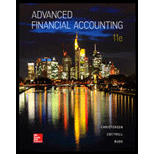
Concept explainers
a
Introduction: When an affiliate of the issuer later acquires bonds from an unrelated party, the bonds are retired at the time of purchase. The bonds are not held outside the consolidated entity once another company within the consolidated entity purchases them, it must be treated as repurchase by the debtor. Acquisition of an affiliate’s bonds by another company within affiliated entities is referred to as constructive retirement. Although bonds are not actually retired.
The gain or loss on bond retirement reported in the 20X4 consolidated income statement.
b
Introduction: When an affiliate of the issuer later acquires bonds from an unrelated party, the bonds are retired at the time of purchase. The bonds are not held outside the consolidated entity once another company within the consolidated entity purchases them, it must be treated as repurchase by the debtor. Acquisition of an affiliate’s bonds by another company within affiliated entities is referred to as constructive retirement. Although bonds are not actually retired.
The equity method entry M make related to bond retirement
c
Introduction: When an affiliate of the issuer later acquires bonds from an unrelated party, the bonds are retired at the time of purchase. The bonds are not held outside the consolidated entity once another company within the consolidated entity purchases them, it must be treated as repurchase by the debtor. Acquisition of an affiliate’s bonds by another company within affiliated entities is referred to as constructive retirement. Although bonds are not actually retired.
The elimination entry to remove the effect of intercompany bond ownership
d
Introduction: When an affiliate of the issuer later acquires bonds from an unrelated party, the bonds are retired at the time of purchase. The bonds are not held outside the consolidated entity once another company within the consolidated entity purchases them, it must be treated as repurchase by the debtor. Acquisition of an affiliate’s bonds by another company within affiliated entities is referred to as constructive retirement. Although bonds are not actually retired.
The balance should be reported as consolidated
Want to see the full answer?
Check out a sample textbook solution
Chapter 8 Solutions
Advanced Financial Accounting
- I am searching for the accurate solution to this general accounting problem with the right approach.arrow_forwardI am looking for help with this general accounting question using proper accounting standards.arrow_forwardCan you help me solve this general accounting problem using the correct accounting process?arrow_forward
- Please provide the correct answer to this general accounting problem using valid calculations.arrow_forwardIn addition to your explanation, address the following self-reflection questions: How does the WH Framework help you analyze the situation? Now that I've put together the framework, how does the WH Framework help managers with making business decisions? And What type of decisions would the WH Framework chart help make as a manager?arrow_forwardPlease provide the accurate answer to this general accounting problem using valid techniques.arrow_forward
 Financial AccountingAccountingISBN:9781305088436Author:Carl Warren, Jim Reeve, Jonathan DuchacPublisher:Cengage Learning
Financial AccountingAccountingISBN:9781305088436Author:Carl Warren, Jim Reeve, Jonathan DuchacPublisher:Cengage Learning Cornerstones of Financial AccountingAccountingISBN:9781337690881Author:Jay Rich, Jeff JonesPublisher:Cengage Learning
Cornerstones of Financial AccountingAccountingISBN:9781337690881Author:Jay Rich, Jeff JonesPublisher:Cengage Learning Intermediate Accounting: Reporting And AnalysisAccountingISBN:9781337788281Author:James M. Wahlen, Jefferson P. Jones, Donald PagachPublisher:Cengage Learning
Intermediate Accounting: Reporting And AnalysisAccountingISBN:9781337788281Author:James M. Wahlen, Jefferson P. Jones, Donald PagachPublisher:Cengage Learning



